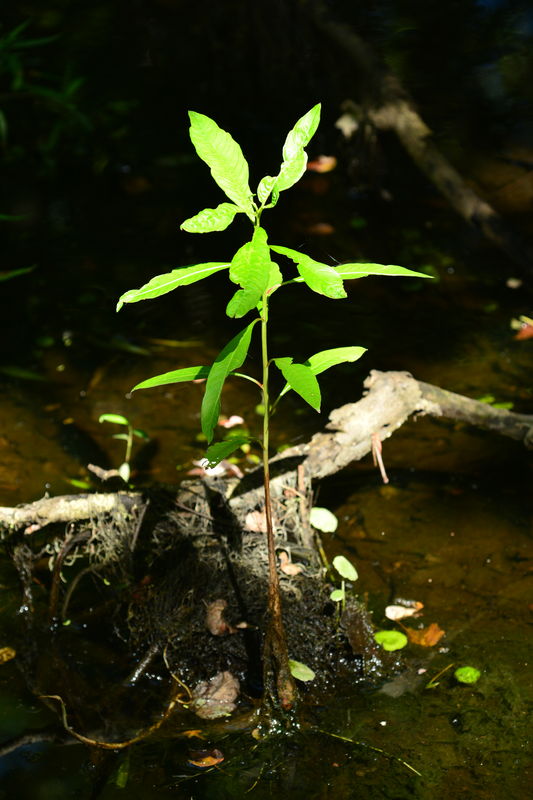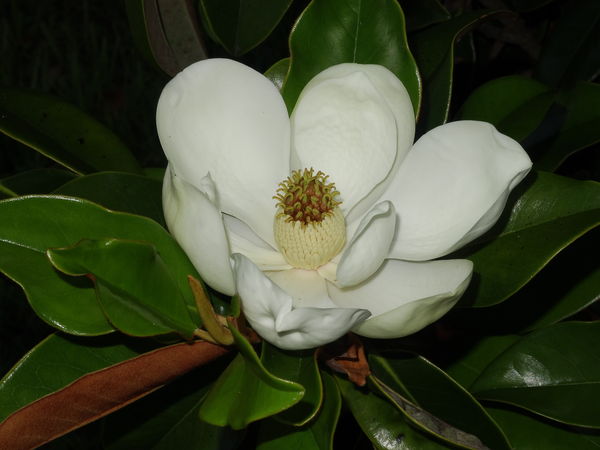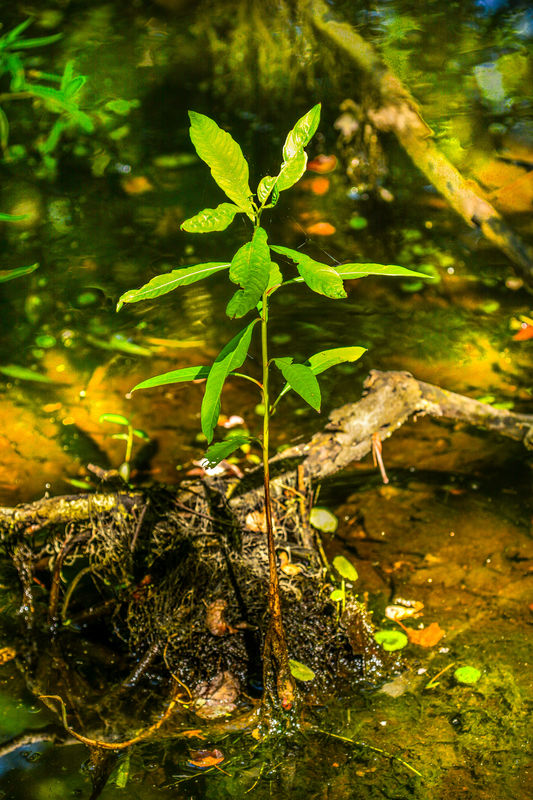High contrast lighting
Jun 16, 2015 20:06:29 #
mikedent
Loc: Florida
This situation always gives me trouble. The main subject is usually overexposed/washed out due to high sun contrast light. What's the best ways to handle this? Bracketing? HDR? Filters? RAW? I'd like to get the whole area properly exposed and presentable. Thanks.
Jun 16, 2015 20:28:33 #
mikedent wrote:
This situation always gives me trouble. The main subject is usually overexposed/washed out due to high sun contrast light. What's the best ways to handle this? Bracketing? HDR? Filters? RAW? I'd like to get the whole area properly exposed and presentable. Thanks.
The contrast can be useful to isolate the subject from the background. I am usually trying to eliminate background distractions, not capture them. Spot metering will help you avoid overexposing the brighter object - the plant in this case.
I always carry a light weight translucent white umbrella to soften the harsh light on the subject, as needed. Or, you can shade the main subject fully with something opaque (usually, my body works for that purpose, though that sometimes means using a cable release)
But if you want the entire scene, both that which is brightly lit and that which is in deep shadow, to be exposed optimally, I don't know how to do that other than with an HDR routine.
My experience has been that working with raw files does give you wider exposure latitude and a better chance at recovering over-exposed highlights.
Mike
Jun 16, 2015 20:31:21 #
If it were my photo, I'd use LR & darken the shadows and/or possibly tweak down the exposure a tad. You can also play with the contrast and decrease the highlights.
It's not far off the mark.
It's not far off the mark.
Jun 16, 2015 20:32:46 #
If you want the whole lot, including the background, to be correctly exposed I would suggest adding light when shooting. A flashgun or two would help.
If the subject is just the green foliage I would change the POV (shoot from a lower viewpoint) and use the dark area to isolate the subject. Expose for the leaves.
If the subject is just the green foliage I would change the POV (shoot from a lower viewpoint) and use the dark area to isolate the subject. Expose for the leaves.
Jun 16, 2015 20:59:45 #
mikedent
Loc: Florida
Yes, I tried to have the leaves as the main subject but thought the background was also interesting with its darker feel. I used center-weighted meter, should next time try spot meter or hdr. This plant was down in the swamp water below the boardwalk deck level. Thanks for ideas!
Jun 16, 2015 22:06:03 #
mikedent wrote:
Yes, I tried to have the leaves as the main subject but thought the background was also interesting with its darker feel. I used center-weighted meter, should next time try spot meter or hdr. This plant was down in the swamp water below the boardwalk deck level. Thanks for ideas!
Let me see if I understand your experience, Mike.
You look at a scene in its entirety and see something interesting and attractive. The plant juxtaposed against the darker foliage looks good to your eye. There are many interesting components to the scene. You want to capture that and translate it to an image you can look at and share with others. But the result lacks the quality of what you saw when you looked at the scene with your eyes. Pay attention to what your eyes and brain are doing when you look at that scene - focusing quickly on one point and then on another, the aperture in your eyes is changing to meet changing light conditions. Your brain is weaving all of that data into a pleasing image in your mind. No camera can do all of that.
That is the challenge. There is no setting on the camera that will magically solve the problem.
You might be interested in a current thread here -
http://www.uglyhedgehog.com/t-314746-1.html
In particular, read what UHH member Gene51 has to say and look at his examples. Take a look at his waterfall image on page 5 of the thread. On page 3 there is an excellent example of how to handle a very high contrast situation.
Mike
Jun 17, 2015 08:03:43 #
Use your meter on spot meter mode and meter on the brightest part of the subject. Not a cure-all but can give a little more control. Remember your camera meter tries to average everything out to 18% gray, and when it is dealing with a contrasty situation like you have in the photo, the camera metering stubs its toe. When you narrow that metering field down to just a small spot in the view it can do a better job of getting it right.
Jun 17, 2015 08:10:42 #
mikedent wrote:
This situation always gives me trouble. The main subject is usually overexposed/washed out due to high sun contrast light. What's the best ways to handle this? Bracketing? HDR? Filters? RAW? I'd like to get the whole area properly exposed and presentable. Thanks.
I'm not sure why you would want to see everything that is there. Me, I'd shoot the plant from a lower position and with the light on the plant, let the background go dark. Take a look at Blenheim Orange's avatar icon, see how the black background makes the flower and stem pop. One issue even for me with you location would be the plant is partly back lit but not totally. A difficult if not impossible lighting situation. Try a different position, moving left or right?
For what you propose, the other repliers have good suggestions too, as good as could be.
Jun 17, 2015 08:29:41 #
zigipha
Loc: north nj
if you want the whole scene illuminated
1. use multiple lights
2. step back from the plant so that the shooter-plant distance gets closer to the shooter-background distance (ye plant will get smaller, but you can crop)
1. use multiple lights
2. step back from the plant so that the shooter-plant distance gets closer to the shooter-background distance (ye plant will get smaller, but you can crop)
Jun 17, 2015 08:55:12 #
I peaked at your info 1/80 f/6.3 ISO 250. 165mm lens. Auto exposure. Center weighted meter. Auto Exposure.
All of this information you should have given when asking for help.... Mikedent.. you be bad boy !!!
OK... my advice... put the camera on M for Manual. Set ISO at 100, Exposure at 1/250 or 1/500 saying fast.. depends on the sync of your camera. f/8. Flash on. The intensity of the flash is regulated by distance or by tissue cover or for some by dial. And NO, you do not need a light meter... any way one is built into your camera should you want to look at sunlight which will be irrelevant because you are using a flash.
In this way you end up with a cook book procedure to follow when doing photos like your or flowers. KIS, keep it simple, no multi lights, fancy details, find your love setup and use it as the start point for any changes. Simple two light sources Sun and Flash. Fast shutter does not allow much sunlight on sensor ...
The photo shown here is ISO 100, f/8, 1/400 taken in bright sun. Taken in May at 8:30 AM (about). Note that the background is suppressed. When tweaked with Topaz Detail and Clarity the texture of the flower is well defined. THIS IS OUT OF CAMERA ... NOT MODIFIED.
All of this information you should have given when asking for help.... Mikedent.. you be bad boy !!!
OK... my advice... put the camera on M for Manual. Set ISO at 100, Exposure at 1/250 or 1/500 saying fast.. depends on the sync of your camera. f/8. Flash on. The intensity of the flash is regulated by distance or by tissue cover or for some by dial. And NO, you do not need a light meter... any way one is built into your camera should you want to look at sunlight which will be irrelevant because you are using a flash.
In this way you end up with a cook book procedure to follow when doing photos like your or flowers. KIS, keep it simple, no multi lights, fancy details, find your love setup and use it as the start point for any changes. Simple two light sources Sun and Flash. Fast shutter does not allow much sunlight on sensor ...
The photo shown here is ISO 100, f/8, 1/400 taken in bright sun. Taken in May at 8:30 AM (about). Note that the background is suppressed. When tweaked with Topaz Detail and Clarity the texture of the flower is well defined. THIS IS OUT OF CAMERA ... NOT MODIFIED.
Jun 17, 2015 11:01:27 #
Exposure compensation may help this issue. Spot meter and adjust exposure up or down, depending on the situation.
Blenheim Orange wrote:
The contrast can be useful to isolate the subject ... (show quote)
Jun 17, 2015 11:34:00 #
mikedent wrote:
This situation always gives me trouble. The main subject is usually overexposed/washed out due to high sun contrast light. What's the best ways to handle this? Bracketing? HDR? Filters? RAW? I'd like to get the whole area properly exposed and presentable. Thanks.
I agree, with most of the other posts with recommendations re exposing for the highlights, recomposing with a lower down view and minimizing the "distractions" in the background. However, I wasn't there and going by what you and others described and what I see, I couldn't resist taking this photo into post processing to see what it could become based on what we think you saw! I use lightroom and spent about 5 mins messing with it mostly just some minor localized exposure adjustments, sharpening, clarity and basic dodge and burn... The highlights were recoverable as you can see and the background was brightened up. Shooting in raw would extend the ability to make these type of changes... Hope you like it...
Jun 17, 2015 11:42:44 #
Jun 17, 2015 11:52:04 #
mikedent
Loc: Florida
lloydl2 wrote:
Thank you, looks more like what I "saw". Some background seems a bit greenish but I'm no expert on LR or PP, I try to avoid the extra time needed, trying to do as well as I can in the camera . I really could not get down closer since I was up on the boardwalk level, but certainly that would have been more ideal. Thanks to all for your great tips, I just gotta get out and take the time to do it. Great forum to learn from!I agree, with most of the other posts with recomme... (show quote)
Jun 17, 2015 11:54:47 #
mikedent
Loc: Florida
Blenheim Orange wrote:
Thank you- and I really do love your flower photo here! Beautiful technique.Let me see if I understand your experience, Mike. ... (show quote)
If you want to reply, then register here. Registration is free and your account is created instantly, so you can post right away.










